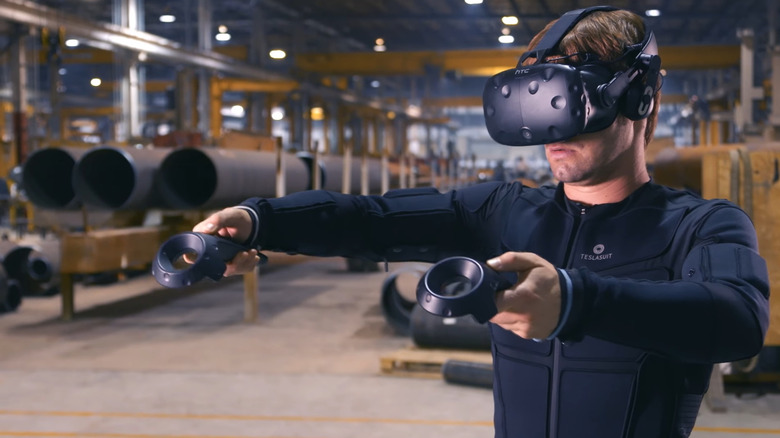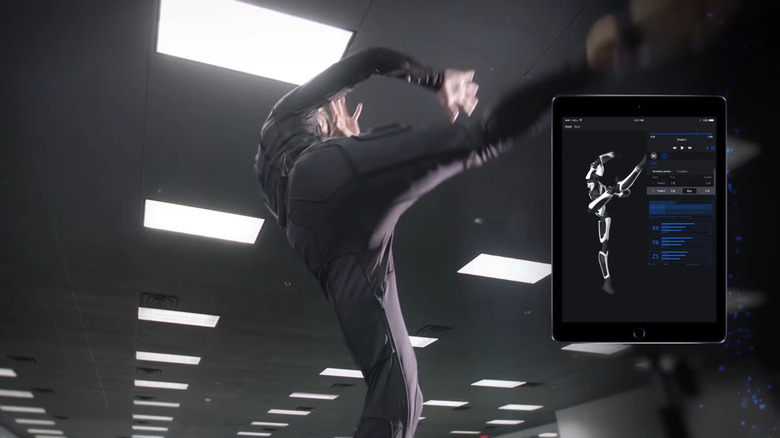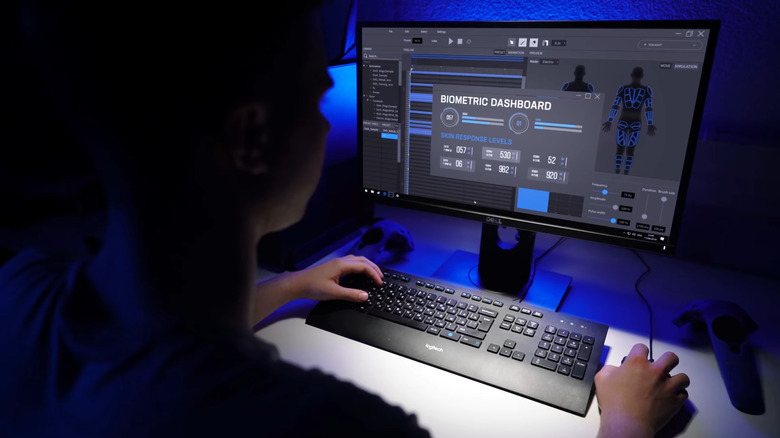The Teslasuit Is A Futuristic Bodysuit That Offers An Immersive VR Experience
The public's collective imagination surrounding virtual reality has grown hot enough to inspire an assortment of full-body suits designed with haptic feedback as the prime selling point. Haptic motors are one of the biggest reasons we loved the PlayStation 5's DualSense controller. In a way similar to how haptic feedback in a controller can make the pitter-patter of raindrops in a game feel more real, haptic feedback can also do wonders for the experience of delving into VR, assuming you have the extra dough to afford such an upgrade. Unfortunately for the average VR gamer, these suits haven't become popularized enough yet that they're available at an affordable price point.
The sustained interest fans of VR have shown over the past half-decade is difficult for investors to ignore, and some of the resulting innovations are a win for everyone who's ever wanted to feel what it's like inside of a digital universe. For example, some users of the popular social VR app "VRChat" are already logging in, hugging, and high-fiving each other in the online metaverse — equipped with the relatively inexpensive bHaptics TactSuit X16 ($299) which offers 16 points of haptic feedback up and down your arms and body, or the TactSuit X40 ($499) which offers 40 points of haptic feedback.
But neither of the two current TactSuit models includes full-body tracking, which can be a critical feature among game developers or even certain "VRChat" users who want to log in and produce live performance art using the full motion of their real-world bodies. Their haptic feedback is also limited to touch, which means that virtual objects don't feel quite as lifelike as their physical counterparts.
Haptic feedback, biometric monitoring, and full-body tracking
Consumer-grade full-body tracking is currently doable with three or more Vive Trackers ($129.99 a pop), but this method comes with a few caveats. Vive Trackers are clunky, they're limited in compatibility with many apps and games, and they posit an additional expense on top of everything else. At the same time, it's possible (at some point in the near future) that we'll get consumer-grade haptic suits that include built-in full-body tracking, improved haptic feedback, and additional feedback for things like object weight simulation.
Enter the Teslasuit, a custom-order experimental bodysuit made for the enterprise space. This suit features full-body motion capture at 100 FPS and biometric monitoring systems, which are notably more advanced than anything you'll find in the $500 price bracket. It seems like the suit, which features a whopping 68 points of haptic feedback across the body, arms, and legs, is built to work using its biometric feedback systems first and foremost.
There's an argument to be made that it's symbiotic, as the biometric monitoring system interfaces directly with the suit's full-body haptics system which relies on electro muscle stimulation (EMS) and transcutaneous electrical nerve stimulation (TENS) instead of regular haptic motors. The Teslasuit is also designed to adapt to your body's temperature, heart rate, oxygen levels, and several other factors, making it capable of keeping you comfortable in real-world hostile conditions as well as digital ones.
This suit is available now, to some
Plenty of factors make the Teslasuit stand above the bHaptics TactSuit, including 14 built-in motion capture sensors and the aforementioned biometric monitoring suite. What makes the Teslasuit the most interesting choice is the tech it uses for haptic feedback. The Teslasuit uses a matrix of electrodes that enable EMS, TENS, and functional electrical stimulation. TENS devices are generally used to treat pain, while EMS devices are usually used to stimulate muscles.
This suit's haptic feedback system operates at frequencies between 1-150 Hz with currents between 1-60 mA. If this sounds painful, that's because it is: according to OSHA, one shock carrying just five mA of electrical current is powerful enough to cause anyone distress, but 10 mA is enough to stop the average person cold in their tracks. The difference between what OSHA is referring to and what this suit works with is control. You can purchase a consumer-grade TENS unit from your local department store with the ability to deliver a current of 80 mA, right now, if you wanted.
It's still important to note that this device, like any device that works with any sort of electricity, requires its own disclaimers. Teslasuit has a substantial list of medical contraindications for working with the suit that includes pregnancy, insulin pumps, pacemakers, and other implantable electronic devices, too.
Suffice it to say, this isn't a toy. Any device as heavily equipped as the Teslasuit isn't going to be cheap, and the suit itself is marketed as a training device to be used in many high-intensity simulations, such as those designed to mimic job training scenarios in high-risk professions like military or athletics, or even for testing out the operating system of a self-driving car on a simulated road. If that isn't enough to deter you from adding it to your shopping cart, the price tag might. You'll need to place a custom order if you'd like an accurate cost, but estimates are at least in the five-figure range. If that's too rich for your blood, and you're still looking to give your VR immersion a boost, don't worry: the Teslasuit Gloves are a paltry $5,000 by comparison.


